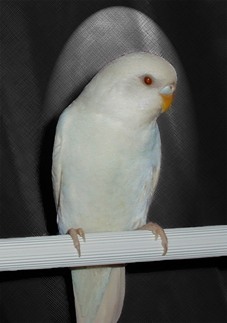| Mutation(s) | Common names & varieties | Type | Wild-type symbol (locus) | Allele symbol | Dominance relationship |
| Dark | D Green (Dark Green), D_Blue (Cobalt), DD Green (Olive) & DD_Blue (Mauve) | Structural | D+ | D | A-I-D |
| Blue 1 | Blue-series | color | b+ | b1 | recessive with other b-locus alleles except b2, else A-R |
| Blue 2 | Blue-series | color | b+ | b2 | recessive with other b-locus alleles except b1, else A-R |
| Blue 1-Blue 2 | Yellowface I | color | b+ | b1 / b2 | (Hetero-allelic mutation produced by crossing Blue 1 & Blue 2 varieties) |
| Yellowface | Yellowface II | color | b+ | byf | Dominant with other b-locus alleles except gf , else A-R |
| Goldenface | Goldenface | color | b+ | bgf | Dominant with other b-locus alleles, else A-R |
| Crest-Factor (C-F) | Circular Crested, Semicircular Crested & Tufted | Structural | Cr+ | Cr | A-P-G |
| Dominant Grey | (Australian) Grey & Greygreen | Structural | G+ | G | A-C-D |
| English Grey | English Grey & Greygreen | Structural | g+ | g | A-I-D (rare or extinct) |
| Anthracite | Anthracite | Structural | An+ | An | A-I-D (rare) |
| Recessive Grey & Greygreen | Australian recessive greygreen & grey | Structural | rg+ | rg | A-R (extremely rare or extinct) |
| Slate | Slate (bluish-gray) | Structural | sl+ | sl | S-L-R |
| Violet | SF Violet (SF Violet Green), SF Violet Blue (Violet Skyblue), DF Violet Green (pure Violet Green) & DF Violet Blue (pure VIOLET), SF Violet D_Blue (show Violet), DF Violet D_Blue (VIOLET Mauve) | Structural | V+ | V | A-I-D |
| Dilute | Suffused Green (Dilute Yellow) and Suffused Blue (Dilute White) | Dilution | dil+ | dils | A-R |
| Clearwing (CW) | Clearwing Green (Yellowing) & Clearwing Blue (Whitewing) | Dilution | dil+ | dilcw | A-Co-D with dilgw allele,
A-D over dild allele, else A-R |
| Greywing (GW) | Greywing Green & Greywing Blue, | Dilution | dil+ | dilgw | A-Co-D with dilcw allele,
A-D over dild allele, else A-R |
| Greywing-Clearwing | Fullbodied-Greywing Green & Fullbodied-Greywing Blue | Dilution | dil+ | dilcw / dilgw | (Hetero-allelic mutation produced by crossing Clearwing & Greywing varieties) |
| ADMpied a.k.a. Recessivepied | Anti Dimorphic Pied, Danishpied, Harlequin, | Local-Leucism | s+ | s | A-R |
| Piebald Australian Pied | Australian Pied, Banded Pied | Local-Leucism | Pb+ | Pb | A-C-D |
| Piednape | Continental_Dutchpied & Clearflighted_Dutchpied | Local-Leucism | Pi+ | Pi | A-C-D |
| Clear-Pied | Black-Eyed-Clear (a.k.a. Dark-Eyed-Clear) | Total Leucism | Pi+ ; s+ | Pi / s | A-Co-D Clear Yellow & White morphs produced by combining SF &/or DF Clearflighted_Dutchpied with Homozygous ADMpied a.k.a. Recessivepied |
| Spangle-Factor (Sp) | SF Spangled (showtype / typical mutation) & DF Spangled (clear white &/or clear yellow pure mutation) | Total Leucism | Sp+ | Sp | A-I-D |
| NSLino | Non-Sex-Linked Ino a.k.a. Recessive Ino | NSL Complete Albinism | a+ | a*a | A-R (extremely rare or extinct) |
| Bronzefallow | German Fallow | NSL Incomplete Albinism | a+ | abz | A-R |
| Brown &/or Sepia | Brownwinged | NSL Incomplete Albinism | b+ | b | Presumed A-Co-D with only a-Locus alleles, else exclusively/inclusively A-R (extremely rare or extinct) |
| Faded | | NSL Incomplete Albinism | fd+ | fd | A-R (extremely rare) |
| Palefallow | Australianfallow. Beigefallow, Palebrownfallow | NSL Incomplete Albinism | pf+ | pf | A-R |
| Dunfallow | English Fallow | NSL Incomplete Albinism | df+ | df | A-R |
Scottish Fallow
(a.k.a. Plumeyed Fallow) | Scottish Fallow | NSL Incomplete Albinism | pl+ | pl | A-R |
| Cinnamon | Cinnamon | SL Incomplete Albinism | cin+ | cin | S-L-R |
| Ino | Albino, Lutino | SL Complete Albinism | ino+ | ino | S-L-R |
| Cinnamon-Ino | Lacewing | SL Incomplete Albinism | cin+ ; ino+ | cin / ino | S-L-R cross-over (3% frequency) between Cinnamon & Ino Loci |
| Sex-linked Clearbody | Texas Clearbody | Partial-Albinistic (Par-ino) | ino+ | inocl | SL-Co-D with other ino locus alleles, else S-L-R |
| Blackfaced (BF) | | Melanism | bf+ | bf | A-R |
| Darkwinged (DW) | | Modifier | dw+ | dw | A-Co-D (only noticeably expressive in combination with dil-Locus alleles and with Greywinged & Suffused) |
| Dominant Clearbody | Easley Clearbody | Pigment redistributing | Cl+ | Cl | A-C-D |
| Opaline | Opaline | Pigment redistributing | op+ | op | S-L-R |
| Saddlebacked (SB) | | Local-Leucism | sb+ | sb | A-R (extremely rare or extinct) |

